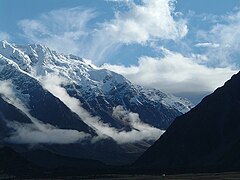Caradhras
| Caradhras | |
|---|---|
 Mount Cook, New Zealand, which served as the representation of Caradhras in The Fellowship of the Ring movie. | |
| J. R. R. Tolkien's legendarium location | |
| Other name(s) | Redhorn, Barazinbar, Baraz, Caradhras the Cruel |
| Type | Mountain |
| Location | Mountains of Moria in central Misty Mountains |
| Founder | Morgoth, when the Misty Mountains were raised |
In the fictional universe of J. R. R. Tolkien's Middle-earth, Caradhras, also called the Redhorn (the literal English translation of the Sindarin name), and known in the Dwarves' language as Barazinbar, is one of the mightiest peaks in the Misty Mountains. Tolkien indicated that it had a height of 17,500 feet[1] (5,334 metres).
In The Lord of the Rings, the Fellowship of the Ring attempt to cross the Misty Mountains via the pass of Caradhras.
Caradhras is reminiscent (in form and meaning) of the Greek word χαράδρα (charadra), which means "mountain stream".[2]
Middle-earth narrative[edit]
Caradhras was the northernmost of the three massive Mountains of Moria (the others being Celebdil and Fanuidhol), beneath which the great Dwarf realm of Khazad-dûm was built. Below the snowline, Caradhras is described as having dull red slopes, "as if stained with blood", which is perhaps the origin of its name.
The mithril mines, on which Khazad-dûm's wealth was founded, were gradually extended north under Caradhras. It was here that miners found Durin's Bane, the Balrog of Moria, in T.A. 1980.
Over the centuries, Caradhras developed an evil reputation, earning the sobriquet "the Cruel". Gimli says that Caradhras bore that name before Sauron was known in the area, and dislikes both Elves and Dwarves.[3]
Redhorn Gate[edit]
Caradhras stood above the Redhorn Gate (or Redhorn Pass), one of the few passes over the Misty Mountains, and thus an important route between Middle-earth's great regions of Eriador, on the west of the mountains, and Wilderland on the east. The pass, which lay on the south side of the mountain, was generally open year-round, even in winter. The eastern end of the pass, known as the Dimrill Stair, led down into the great Dimrill Dale, part of the ancient Dwarf-realm of Khazad-dûm.
The Redhorn Gate originally linked the Noldorin realm of Eregion (established S.A. 750) in the west to the Dimrill Dale and hence the Vale of Anduin in the east. However Eregion and Khazad-dûm soon constructed the West-gate of Khazad-dûm's tunnel-complex, providing a more direct and convenient route between the two realms. The West-gate lay 15–20 miles south of the Redhorn Pass.[4]
After Eregion was destroyed in S.A. 1697, during the War of the Elves and Sauron, the gates of Khazad-dûm were shut, and the Redhorn Pass was predominantly used by Elves travelling between Lothlórien and Eriador. However a tribe of Hobbits used this pass on their migration to Eriador from the Gladden Fields in circa T.A. 1150.
The Redhorn Gate is notoriously treacherous, being noted especially as the site of Elrond's wife Celebrían's abduction by Orcs in T.A. 2509.
The Nine Walkers attempted to traverse the pass, nearly ending in disaster in a snowstorm on 12th 'January' T.A. 3019. Besides the storm itself they endured distressing noises from the wind as well as a barrage of stones and were very nearly trapped by suspiciously placed snowdrifts. Gimli especially, as well as Boromir and to a lesser extent Aragorn, attributed this combination of threats to the malice of Caradhras. In the Peter Jackson film the "fell voice" is Saruman speaking in Quenya, who exhorts cruel Redhorn to strike at the Fellowship while Gandalf pleads for Caradhras to sleep.
In popular culture[edit]
- The mountain, and adjacent pass, are depicted in the 2007 video game Lord of the Rings Online.[citation needed]
- The American trailer music group Two Steps from Hell released a track named "Caradhras" on their second public release album, Archangel.[citation needed]
- In 2013 the Austrian black metal band Summoning released a track named "Caradhras" on their seventh full-length album Old Mornings Dawn.[citation needed]
- In 2019 an American post-black metal project named Caradhras released two albums: "Caradhras" and "Teleology."
- The Super Mario World romhack Grand Poo World II has a level named Caradhras. The aesthetic is of an icy, treacherous mountain pass.[5]
References[edit]
Some use of "" in your query was not closed by a matching "".Some use of "" in your query was not closed by a matching "".
- ↑ Wayne G. Hammond & Christina Scull (1995), J. R. R. Tolkien: Artist and Illustrator, HarperCollins, figure 158 (p.163) & p.167; ISBN 0-261-10322-9 Search this book on
 .
.
- ↑ Liddel-Scott-Jones, A Greek-English Lexicon [1]. Retrieved 12 December 2017.
- ↑ J. R. R. Tolkien (1954), The Fellowship of the Ring, 2nd edition (1966), George Allen & Unwin, book 2 ch. III pp. 303 & 306; ISBN 0 04 823045 6 04 823045 6 Search this book on
 .
.
- ↑ J. R. R. Tolkien (1954), The Fellowship of the Ring, 2nd edition (1966), George Allen & Unwin, book 2 ch. IV p. 311; ISBN 0 04 823045 6 04 823045 6 Search this book on
 .
.
- ↑ Reaching The Mountain's Apex! GRAND POO WORLD 2 Part 3, timestamp 1:18, https://www.youtube.com/C2v1MLEcyA8?t=78
External links[edit]
- "Caradhras". Tolkien Gateway.
de:Regionen und Orte in Tolkiens Welt#Nebelgebirge fr:Caradhras nl:Roodhoornpas#Caradhras pl:Lista gór i wzgórz Śródziemia#Caradhras pt:Hithaeglir#Geografia sv:Platser i Tolkiens värld#Caradhras
This article "Caradhras" is from Wikipedia. The list of its authors can be seen in its historical and/or the page Edithistory:Caradhras. Articles copied from Draft Namespace on Wikipedia could be seen on the Draft Namespace of Wikipedia and not main one.
